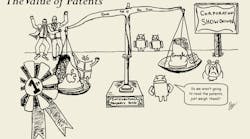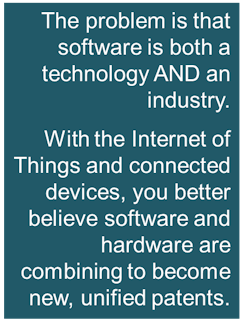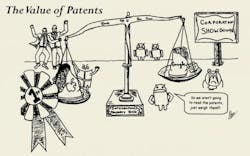Do you remember the story from Greek mythology called War of the Titans? It was a 10-year series of battles between the Olympians and the Titans to decide who would rule the Universe.
Today, a similar battle is going on between technology giants Samsung and Apple over patent infringements of smartphones. It started about two years ago after a federal jury found Samsung guilty of infringing on Apple patents. Samsung ante-upped a little over $1 billion to pay Apple for damages.
Now, just like the Greek mythology story, the series of battles continues with more than 50 cases being held around the World between these two companies.
The plot thickens
Recently, Google got in the mix by agreeing to handle part of Samsung’s defense against the iPhone maker’s patent infringement claims. Google also agreed to underwrite a portion of the Korean manufacturer’s legal costs. This is because in April 2012, Google agreed in emails to "defend and indemnify" Samsung if they used the technology Apple claimed violated its patents.
The violations are not about the mechanical design of the phones. Rather, they are in reference to a stickier subject -- software functionality. Apple is claiming Samsung stole 'tap-from-search' and 'slide-to-unlock' functions. Samsung argues Apple stole wireless technology to speed data transmission. The list of products on the chopping block includes Apple’s iPhones 4, 4S and 5 models, the iPad 2, 3, 4 and Mini, iPod Touch, and MacBook. On Samsung's side, the list includes ProSamsung’s Galaxy S2 and S3, the Galaxy Note and Note 2, and the Galaxy Tab 2 10.1.
In the quest to take over the Universe, Apple is asking the courts to make Samsung pay a $40 royalty fee on each of those devices listed. Concurrently, the iPhone manufacturer is asking to ban the sales of Samsung Galaxy products, a move that would clearly knock out the competition.
What’s the value of software patents?
Infringement cases can occur over mechanical or software-based patents, however, software patents are harder to protect because there are so many in the system. In 1991 software-related patents accounted for less than a quarter of all US patents. In 2011, software patents accounted for the majority of all issued patents.
Billions of dollars in damages is requested by Apple. But Samsung is only asking for $7 million in damages and the right to use the technologies. These values seem off kilter, but nonetheless are huge sums of money. What's scary is the thought of a financially-limited business entering into battle with one of these giants.
'The Value of Patents' created by Alec Shriver, AranayFilms.com
In talks with a patent attorney, we discussed how patent trolls and big companies with strong legal teams can completely derail a smaller company’s business plan. Part of this bullying occurs because the patent system is slow. Patents can take three to five, or more, years to get approved, so it's hard to decipher the 'patent pending' term. This is a problem because larger companies might have hundreds of patent-pending technologies filed under a provisional patent or a utility patent. Provisionals never see the light of day, and utilities take a while to enter a searchable database. So how is a company to know if they are infringing on a patent?
Unless the patents are searchable, the only way to know is to receive the dreaded cease-and-desist letter. The 'big guys' and their dedicated legal teams are usually the first to find potential infringements on their patents and send out the letter. Unfortunately, if it is sent to a small company they usually can't afford to defend the letter (can cost upwards of $75K). Then the small company will stop in its tracks or move to plan B. The only upside to receiving this type of letter is if the small company can flip the dynamic and ask the prosecuting company if they’d like to buy them out.
First-to-file vs. first-to-market
I like to think about what would happen if America’s patent system morphed into the one New Zealand uses. The country rid its system of software patents in 2013, stating that computer programs are not inventions. However, the country only enforces this upon new patents — this may or may not be good for emerging companies.
The problem is that software is both a technology AND an industry. With the Internet of Things and connected devices, you better believe software and hardware are combining to become new, unified patents. So imagine if an industry like automotive could never file patents again. Wouldn’t that give legacy companies like Ford (or Apple) a competitive advantage? Ford would be on the lookout for technologies that infringe on its existing patents and use the cases to either stop the competition or hit them with fines.
In both the U.S. and New Zealand any company or individual can enter the market without a patent. But New Zealand's ban on new software patents seems to stifle innovation for the financially disadvantaged. Emerging companies such as Tesla would not be able to protect their new technologies. They would not only be vulnerable to competitors and knock-offs, but could also be simultaneously fighting infringement cases from the legacy companies.
Likewise, Tesla may veer away from creating ground-breaking innovations because of the lack of protection on its investment in new product development. The costs of creating a new technology are substantially greater than developing a me-too product. Costs include R&D, validating the market, marketing, and more. Without a legal structure to protect new technologies, the company may opt to get on board only when a market gets hot rather than creating a new market. Or, the budgeted company will license or acquire an exisiting technology.
Although it’s different in the U.S., our patent system includes contradictory laws that sometimes also fail to foster innovation. The America Invents Act, or first-to-file law, encourages both legitimate and questionable patent applications. That’s because this law essentially favors companies that file a patent first — over companies that use and market a technology first. So companies end up filing patents on designs just to protect themselves against competitors working on similar designs — which means lots of patents are filed by parties that may or may not be best prepared to bring designs to market. What’s worse, an overcrowded patent database makes for poorer quality of patents, leaving room for litigation wherever possible. On a good note, companies do rest a little easier knowing they have a piece of intellectual property to protect investments.
Both the U.S. and New Zealand patent systems have pros and cons. I think the two systems heighten competition between all types, sizes, and maturity of companies. I fear both systems suppress innovation — especially innovation from bootstrapping entities. Besides a discount on the cost to file patents (at least for U.S. patents), it’s hard to see how these systems are encouraging the underdogs to innovate.


